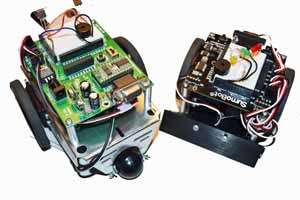Finding Cheap Robotic Wheels
 A typical robot base uses 3 to 4 wheels to steer and move around. The standard robotic wheel is a tall lightweight plastic wheel with rubber around the outside perimeter so the robot wheels do not slide on smooth surfaces. Robotic wheels that are specifically designed for robots are sold at robot shops, but there are other alternatives available for robot makers who want to save money and be more creative. Here are some other wheel sources to consider using on your next robot project.
A typical robot base uses 3 to 4 wheels to steer and move around. The standard robotic wheel is a tall lightweight plastic wheel with rubber around the outside perimeter so the robot wheels do not slide on smooth surfaces. Robotic wheels that are specifically designed for robots are sold at robot shops, but there are other alternatives available for robot makers who want to save money and be more creative. Here are some other wheel sources to consider using on your next robot project.
Toy Wheels
Repurposed wheels from toys and old remote control vehicles are great for robot projects. Some toys may even contain the parts used to gear-down the rotation of a DC motor. Rubber tire toy wheels work best, providing more accurate transfer of energy to motion. Old toys and RC vehicles are available from second-hand stores like Goodwill and Savers. Garage sales, flea markets, and rummage sales are also potential sources for toys that contain wheels that are useful for robotic projects.
Printers and Copy Machines
Most printers and copy machines have rubber wheels that feed paper through the machine. These wheels are very good for turning into homemade robot wheels. Old printers and copy machines can be found on eBay, at salvage computer shops, or other online electronics salvage dealers. Many interesting parts for robot projects are also available from copiers and printers.
LEGO Wheels for Robots
With LEGO ease of use, they are a natural choice for robot builders. LEGO robot wheels are generally about $1 each when purchased in the Item 6118 LEGO wheels accessory set. This price offers a savings of several dollars per wheel since most plastic (non-parallax) wheels cost over $3 each. Parallax wheels price is near $4 per wheel. Keep in mind that the plastic wheels sold through robot stores have a bolt pattern that matches up with a standard servo control arm circular mount. Using LEGO wheels requires some minor fabrication to attach the wheels to the robot body.
Ice Cream Push-up Sticks
Believe it or not, plastic ice cream push-up sticks make very cheap, but nice wheels for an inexpensive robot project. There are robot-builders out there that pride themselves on building a robot out of things normally thrown away. Plastic push-up sticks have a perfect wheel size for a robot, and also have the connection for a shaft. A rubber band is used to provide traction on the wheels. Glue the rubber bands to the circumference of the plastic wheels using rubber cement. When you need some inexpensive robot parts, feed the kids some ice cream push-ups and save the plastic parts for cheap robot wheels.



